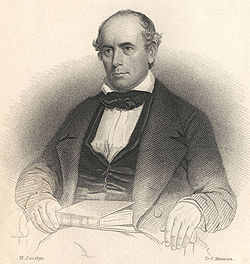Elisha Mitchell
Elisha Mitchell | |
|---|---|
 Portrait of Rev. Elisha Mitchell, 1858 | |
| Born | (1793-08-19)August 19, 1793 Washington, Connecticut, United States |
| Died | June 27, 1857(1857-06-27) (aged 63) Yancey County, North Carolina, United States |
| Residence | Chapel Hill, North Carolina, United States |
| Nationality | American |
| Alma mater | Yale University |
| Known for | Proving Mt. Mitchell was highest mountain east of the Rockies Acting President of the University of North Carolina |
| Scientific career | |
| Fields | Chemist and Geologist |
| Institutions | University of North Carolina |
| Signature | |
Elisha Mitchell (August 19, 1793 – June 27, 1857) was an American educator, geologist and Presbyterian minister. His geological studies led to the identification of North Carolina's Mount Mitchell as the highest peak east of the Mississippi River.
Contents
1 Early life
2 Mitchell at the University of North Carolina
3 Discovery of “Mount Mitchell”
4 Findings challenged
5 Honors
6 References
7 External links
Early life
Elisha Mitchell was born August 19, 1793, in Washington, Connecticut. He was graduated from Yale University in 1813, where he studied under chemist Benjamin Silliman, whose courses would shape his own teaching career.[1]
Mitchell at the University of North Carolina
Mitchell began his career as a professor at the University of North Carolina at Chapel Hill in 1818, teaching math and natural philosophy. In 1825, he began teaching geology – the field with which he would be primarily associated for the rest of his life.[2] In addition to teaching, Mitchell also served as the university's bursar, accountant, and acting president at various times; he also led chapel services, as he had been ordained by the Presbytery of Orange in Hillsborough, NC, in 1821.[2]
Discovery of “Mount Mitchell”
Mitchell completed a geographical survey of North Carolina in 1828 and observed a peak in the Black Mountains he believed to be higher than Grandfather Mountain, at that time thought to be the highest in the region.[3] In 1835, he first measured the height of this mountain, at the time known as Black Dome. Through subsequent measurements in 1838 and 1844, Mitchell proved it was higher than New Hampshire’s Mount Washington, establishing the peak as the highest above sea level in the Eastern US.[2]

Watch belonging to Elisha Mitchell, which broke during his fatal fall and shows his exact time of death. North Carolina Collection, Wilson Special Collections Library, University of North Carolina at Chapel Hill, 2012
Findings challenged
Elisha Mitchell fell to his death at nearby Mitchell Falls in 1857, having returned to verify his earlier measurements, which had been challenged by state senator Thomas Clingman, a former student of Mitchell’s.[3] He was originally buried in Asheville, but was reinterred in a tomb on the mountain in 1858.[2] In 1881–82 the U.S. Geological Survey upheld Mitchell’s measurements and officially named his peak Mt. Mitchell. At 6,684 feet or 2,037 metres high, Mt. Mitchell is the highest point east of the Mississippi River.

Tomb of Elisha Mitchell on the peak of Mount Mitchell
Honors
The Journal of the Elisha Mitchell Scientific Society, published by the North Carolina Academy of Science, was founded in his honor in 1883.
On August 18, 1888, University of North Carolina Alumni erected an obelisk memorializing him at his grave site atop Mt. Mitchell. On January 1st, 1915, high winds destroyed the monument. It was replaced 13 years later by the funeral cairn and plaque currently marking his tomb.[4] "University" is misspelled on the plaque.
Mitchell County, North Carolina, is named after him. Mount Mitchell, however, is not within the boundaries of Mitchell County, but in neighbouring Yancey County.
References
^ "Elisha Mitchell (1793–1857)". The Carolina Story – Antebellum College Life. Retrieved 14 March 2013..mw-parser-output cite.citation{font-style:inherit}.mw-parser-output .citation q{quotes:"""""""'""'"}.mw-parser-output .citation .cs1-lock-free a{background:url("//upload.wikimedia.org/wikipedia/commons/thumb/6/65/Lock-green.svg/9px-Lock-green.svg.png")no-repeat;background-position:right .1em center}.mw-parser-output .citation .cs1-lock-limited a,.mw-parser-output .citation .cs1-lock-registration a{background:url("//upload.wikimedia.org/wikipedia/commons/thumb/d/d6/Lock-gray-alt-2.svg/9px-Lock-gray-alt-2.svg.png")no-repeat;background-position:right .1em center}.mw-parser-output .citation .cs1-lock-subscription a{background:url("//upload.wikimedia.org/wikipedia/commons/thumb/a/aa/Lock-red-alt-2.svg/9px-Lock-red-alt-2.svg.png")no-repeat;background-position:right .1em center}.mw-parser-output .cs1-subscription,.mw-parser-output .cs1-registration{color:#555}.mw-parser-output .cs1-subscription span,.mw-parser-output .cs1-registration span{border-bottom:1px dotted;cursor:help}.mw-parser-output .cs1-ws-icon a{background:url("//upload.wikimedia.org/wikipedia/commons/thumb/4/4c/Wikisource-logo.svg/12px-Wikisource-logo.svg.png")no-repeat;background-position:right .1em center}.mw-parser-output code.cs1-code{color:inherit;background:inherit;border:inherit;padding:inherit}.mw-parser-output .cs1-hidden-error{display:none;font-size:100%}.mw-parser-output .cs1-visible-error{font-size:100%}.mw-parser-output .cs1-maint{display:none;color:#33aa33;margin-left:0.3em}.mw-parser-output .cs1-subscription,.mw-parser-output .cs1-registration,.mw-parser-output .cs1-format{font-size:95%}.mw-parser-output .cs1-kern-left,.mw-parser-output .cs1-kern-wl-left{padding-left:0.2em}.mw-parser-output .cs1-kern-right,.mw-parser-output .cs1-kern-wl-right{padding-right:0.2em}
^ abcd Watson, Elgiva D. ‘Elisha Mitchell.’ Originally published in the "Dictionary of North Carolina Biography," edited by William S. Powell. Chapel Hill, NC: University of North Carolina Press, 1991. Available at:http://docsouth.unc.edu/browse/bios/pn0001194_bio.html
^ ab Mewborn, Suzanne. ‘Elisha Mitchell and his mountain.’ Originally published in Tar Heel Junior Historian, volume 46, no. 1 (Fall 2006). Published by the North Carolina Museum of History. Available at: http://www.learnnc.org/lp/editions/nchist-newnation/4391
^ Bennett, Jonathan Howard; Biddix, David (2015). Images of America, Mount Mitchell. Charleston, South Carolina: Arcadia Publishing. pp. 57–66. ISBN 9781439652671. Retrieved 16 August 2016.
External links
| Wikimedia Commons has media related to Elisha Mitchell. |
Memoir [of Elisha Mitchell]: With the Tributes of Respect to His Memory. Chapel Hill, NC: University of Chapel Hill. 1858. Retrieved 16 August 2016.
"Inventory of the Elisha Mitchell Papers, 1816–1905". The Southern Historical Collection. University of North Carolina. Retrieved 16 August 2016.
Mitchell, Elisha (January 1828). "On the Character and Origin of the Low Country of North Carolina". The American Journal of Science and Arts. 13. Retrieved 16 August 2016.
"Rev. Elisha Mitchell, D.D. Marker". The Historical Marker database. Retrieved 16 August 2016.
Elisha Mitchell at Find a Grave